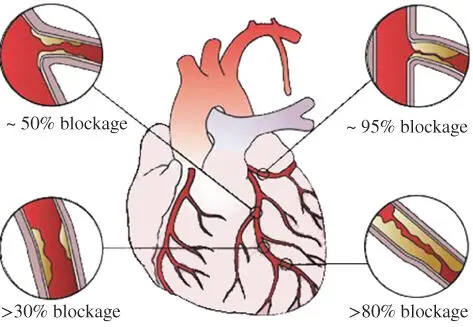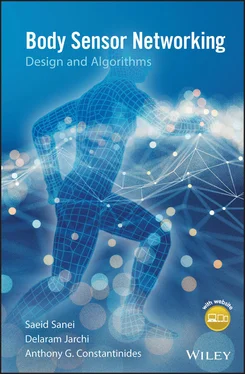1 ...8 9 10 12 13 14 ...24 The use of a video camera requires skill in image processing in order to enable accurate extraction of movement features [5]. Furthermore, for video-based recognition of biometrics often more than one camera is needed to overcome occlusion problems. In practice, various combinations of biometric sensors may also be employed. Usually, two cameras are needed if frontoparallel gait is used. Many other biometrics can be extracted from the frontonormal plane. The problems of alignment and synchronisation are significant. If possible, single camera or monocular capture of video is preferred even if less data are recorded. To overcome this, Zhou and Bhanu use a profile view of a face with gait in order to use one camera at 3.3 m from the subject [6]. Of note is the work by Bazin that includes the ear and footfall as biometrics [7]. As another example, the frontonormal view allows one to use face and iris with gait for a robust recognition system, though some other problems, such as looming effect, make this modality a challenging and difficult case.
Research about human gait has been extended to rehabilitative assessment for various disorders such as stroke, cerebral palsy, paralysis, dementia, age, and Parkinson's.
As an application example, the ability to perform activities considered normal is important to someone who suffers from limb disability. This is particularly common in patients with stroke. The inability to have an independent life requires constant medical attention, resources, and often hiring a caregiver. Where it is possible to rehabilitate the limbs, a customised regimen of exercises needs to be tailored to the needs of the person, depending on the extent of the disability. At the same time, the treatment progress needs to be monitored in order to assess its effectiveness. Presently, these are labour-intensive tasks requiring trained therapists to record data, interpret them, and keep track of what are often repetitive exercises. Compounding this is the lack of clinical skills at home, which means only a limited transfer of the needs of care are permissible, and this may hamper the rehabilitation process [8]. One way to encapsulate the experience of healthcare practitioners is in the form of tests for limb function for tasks deemed essential in the activities of daily living (ADLs). There are many of such established tests which involve movements of a patient and their interactions with various objects [9].
The use of sensors in consumer devices such as mobile phones and gaming consoles allows for a better user experience as the processors in these devices deduce the intention of the user by their movements. Embedding sensors and processors into objects – often in daily use – is referred to as an instrumented object approach.
2.3 Physiological State of Human Body
Human physiology is a very complicated and vast area of science. It covers a large number of conditions and abnormalities in humans as well as animals. Wakefulness is taken to be a prime physiological state during which a person is conscious and aware of their environment. Sleep or coma are other states during which the person is not aware of their environment. Wakefulness may also be slightly different from being alert or vigilant as each state has its own characteristics and applications.
There are, however, states which describe abnormalities in the human body. Being deaf, dumb, lam, or blind are often considered abnormalities. Automatic techniques in instrumentation and data processing are able to distinguish most of these abnormalities from the human normal state. For example, a limp is a type of asymmetric abnormality of the gait and can be assessed or monitored using gait analysis techniques. There are many other state types of abnormalities or disabilities which require scrutinised medical examinations for their diagnosis and monitoring. Diverse examples include acathexia, an inability to retain bodily secretion; anhidrosis, the failure of the sweat glands; anaesthesia, the loss of bodily sensation with or without loss of consciousness; and elastosis, loss of elasticity in the skin of elderly people that results from degeneration of connective tissue.
There are some mechanical states of the body such as those related to joint flexion and extension. Gait analysis fully describes such states. Nevertheless, in a number of research works particularly related to brain–computer interfacing (BCI) applications for imaginary movement or related to amputated organs, electromyography (EMG) or EEG signals have been exploited.
Hypercarbia and hypocapnia (acapnia) represent abnormally high or low levels of carbon dioxide in the blood, respectively. It is not so difficult to measure and evaluate the carbon dioxide level in the blood using noninvasive sensors called oximeters, a relatively cheap monitoring modality widely available in hospitals and intensive care units (ICUs). The oximeters can also be used equivalently for measuring the blood oxygen level as well as the oxygen–carbon dioxide exchange during breathing caused by chocking, drowning, electric shock, or inhaling chemical gas.
Hyperthermia refers to high body temperature. The temperature can be measured using thermometers or nonintrusively using thermal imaging systems. Those who suffer from hyperthermia may have abnormalities in their heart rate, breathing, muscle activity, or brain rhythms, and the patterns of these signals can confirm the diagnosis.
Upon some mental or physical diseases such as Parkinson's or stroke, the patients may gradually lose their ability to walk, move their hands, or speak. In many such cases their muscles become weaker and they develop so-called myasthenia. In addition to measurement (using accelerometers) and characterisation of gait, surface or invasive EMG is one of the recording modalities often used to measure the muscle activity and its response to various stimuli.
Many heart diseases and abnormalities can be diagnosed by analysing the electrocardiogram (ECG) measuring heart muscle electrical activities, or stethoscope, which is used for auscultation and recording the heart sound.
Heart diseases refer to conditions that involve the heart, its vessels, muscles, valves, or internal electric pathways responsible for muscular contraction. Common heart diseases are coronary artery disease, heart failure, cardiomyopathy, heart valve disease, and arrhythmias.
In the case of heart attack, a coronary artery is blocked (usually by a blood clot), meaning an area of heart tissue loses its blood supply. This reduction of blood can quickly damage or kill the heart tissue, so quick treatments in an emergency department or catheterization suite are necessary to reduce the loss of heart tissue [10]. However, over 70 000 people die from heart disease in the UK each year, which accounts for approximately 25% of the total number of deaths.
Coronary artery disease occurs when a plaque, a sticky substance such as lipid or calcium compound, narrows or partially obstructs coronary arteries and can cause reduced blood flow. This consequently leads to chest pain (angina), a warning sign of potential heart problems such as a heart attack. The plaque may also trap small blood clots, causing full blockage of a coronary artery and resulting in a heart attack [11]. Figure 2.1shows a schematic of the blocking of heart arteries with different severities.

Figure 2.1 Schematic of some possible blocking of heart arteries with different severities. ( See color plate section for color representation of this figure )
A heart attack can cause other problems which may lead to more complication than the original problem of blocked arteries. For example, sudden cardiac death may occur when the ECGs become erratic. When the heart tissue that is responsible for regular electrical stimulus of heart muscle contractions is damaged, the heart stops effectively pumping the blood. Cardiomyopathy is a condition indicated by abnormal heart muscle. Abnormal muscles make it harder for the heart to pump blood to the rest of the body.
Читать дальше













